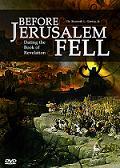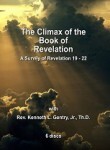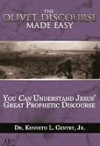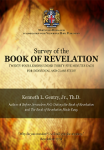STAND FIRM IN THE RESURRECTION HOPE (4)
PMW 2025-036 by Kenneth L. Gentry, Jr.
Introduction
This is my fourth article in a series of studies affirming, explaining, and defending historic Christianity’s view of the physical resurrection of the dead. I would encourage my current reader to look back at the preceding three installments of this series (and if you have a good Ouija board, you might want to look ahead to my future installments). I am demonstrating that 1 Corinthians 15 does not support the “spiritual-only body” view of ancient Gnosticism, modern liberalism, or contemporary semi-cultic hyper-preterism. These views hold that the resurrection body is a spiritual, ethereal entity rather than a fleshly, material one.
And without embarrassment I am declaring this alongside of centuries of sound Christian exegesis. Centuries of exegesis which continues on today despite the fact that Paul mentions a “spiritual body [Gk. soma pneumatikon]” in 1 Corinthians 15:44a.
Building the case
In my last article I noted the structure of Paul’s argument in paralleling and contrasting ideas as he is erecting his argument against his opponents. He is responding to a Hellenistic philosophy with proto-Gnostic features in Corinth. This proto-Gnostic tendency has raised a number of issues in Corinth which denigrate the material realm in deference to the spiritual realm. Consequently, in 1 Corinthians 15 Paul has to answer the incredulous questions found in v. 35: “How are the dead raised? And with what kind of body do they come?” So Paul has to carefully engage his opponents’ confusion and error by carefully structuring his case — at length.
Unto You and Your Children By Larry E. Ball
By Larry E. Ball
This book defines and illustrates the covenant as it appears in the Bible, and then demonstrates how the covenant affects our children as we raise them in the church. It also develops a justification for infant (covenant) baptism.
However, before the writer examines the idea of the covenant in the Bible, he first covers a number of other topics that a person needs to understand before he can understand the covenant. He spends at least one chapter revisiting the gospel. What is the gospel? He then establishes the meaning of such words as regeneration, conversion, election, and salvation. He is convinced that before a person can properly understand the covenant and covenant baptism there must be some agreement on the definition of these other terms.
See more study materials at: www.KennethGentry.com
I have been building on the exegetical labors of James Ware, David Garland, Andrew Das, E. Earle Ellis, N. T. Wright, Richard B. Gaffin, Jr., and others. I have argued that Paul engages in a well-structured literary presentation that carefully contrasts verbal pairs in vv. 36–49 (see last article). Having done that we can now make an important observation regarding Paul’s argument.
Upon noting Paul’s structuring (employing contrasting verb pairs in vv. 36–49), we can affirm the Westminster Confession of Faith’s view of our resurrection bodies. It states that at the last day the resurrection involves “the self-same bodies, and none other (although with different qualities), which shall be united again to their souls for ever” (WCF 32:2).
The subject matter
We can, along with the Church of all ages, easily see this in Paul’s well-structured presentation of our resurrection hope. For when we seek the subject of each of his verbal contrasts, we discover that they are the same for both the verbs denoting mortal death and the ones denoting resurrected life. That is, that which dies (the body) is that which arises again from death (the same body).
For instance, in v. 36 the mortal body that dies (the seed that is sown) is the very body that is “made alive.” In vv. 42–44 the single implied subject remains the same. That is, the “perishable body” is sown so that it may be “raised an imperishable body.” And Paul powerfully confirms this in v. 49 where he states that: “we have borne the image of the earthy [Adam], we will also bear the image of the heavenly [Jesus].” Something that is vitally important, yet too often overlooked, may be discovered in this chapter. And that is: the contrasts that Paul presents do not occur in the subjects but in the predicates. That is, the subject in the paired verbs in vv. 42–44 is the human body which is now perishable. But it will become imperishable through the transformative power of the resurrection.
In this regard we should note that Paul presents an illustration based on the life-cycle of the seed. This illustration shows that the very body that is sown is the one that is raised.
Before Jerusalem Fell Lecture
DVD by Ken Gentry
A summary of the evidence for Revelation’s early date. Helpful, succinct introduction to Revelation’s pre-AD 70 composition.
See more study materials at: www.KennethGentry.com
Thus, for the purpose of his argument against his “foolish” (v. 36a) opponents, the seed that is sown in death (vv. 36, 37, 38) is our earthly, mortal bodies (vv. 36–38). And the subject of these verbs remains the same when that sown mortal body then arises from death with new characteristics (imperishability, glory, and power) (vv. 42–44).
Consequently, Paul does not argue that the present body is sown in death but a new, different body arises in its place. Throughout his argument Paul remains focused on a single subject: the body that is sown in mortality is the very one raised in immortality, etc. It is the original body and not a different one; the thing that perishes is the very thing that arises again. This is why the key word for “resurrection” in Greek is anastasis. This word derives from anistemi, which means “stand up”: ana (“up”) + histimi (“to stand”). That which has fallen down, stands up again — not something else.
This body
This explains why in verses 53–54 Paul repeats four times that it is “this” (Gk., touto) body that is raised at the climax of his argument: “For this [touto] perishable must put on the imperishable, and this [touto] mortal must put on immortality. But when this [touto] perishable will have put on the imperishable, and this [touto] mortal will have put on immortality, then will come about the saying that is written, ‘DEATH IS SWALLOWED UP in victory.’” As Sider puts it “the subject persists throughout the radical change.”[1]
 The Climax of the Book of Revelation (Rev 19-22)
The Climax of the Book of Revelation (Rev 19-22)
Six lectures on six DVDs that introduce Revelation as a whole, then focuses on its glorious conclusion. Provides an important, lengthy Introduction to Revelation also.
See more study materials at: www.KennethGentry.com
Orthodox Christianity believes that our fleshly body (created for us by God, Gen. 2:7; cp. Psa. 139:13) is included in God’s saving action, just as the unbeliever’s body is included in God’s judging action (Matt. 10:28). Though we have two parts (body and soul) we are a unified being. Both parts of our unified being are God-created and important. And objects of his blessed redemption.
There is more to come! Even so, come Lloyd Gentry (you might say).
Notes
1. Ronald Sider,“St. Paul’s Conception of the Resurrection Body in 1 Corinthians XV.35-54,” NTS 21 (1975): 438.
Click on the following images for more information on these studies:



Kenneth L. Gentry Jr.'s Blog
- Kenneth L. Gentry Jr.'s profile
- 85 followers



